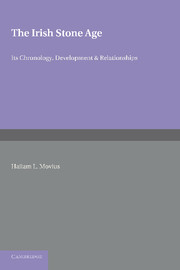Book contents
- Frontmatter
- Dedication
- Contents
- ILLUSTRATIONS
- FOREWORD
- PREFACE
- INTRODUCTION
- Part One THE CHRONOLOGY OF THE LATE-GLACIAL AND EARLY POST-GLACIAL PERIODS IN NORTHERN AND WESTERN EUROPE
- Part Two THE STONE AGE CULTURES OF IRELAND
- Appendices I-VI
- APPENDIX I The Raised Beach of the Third Interglacial Period
- APPENDIX II Deposits of the Interstadial Period between the Old and the New Drift Glaciations (W1/W2) in England and Scotland
- APPENDIX III The New Drift Glaciation
- APPENDIX IV The Recession of the Last Ice-Sheets
- APPENDIX V Deposits of the Late-Glacial Sea
- APPENDIX VI Submerged Forests and Raised Beaches in Britain and Ireland
- REFERENCES CITED IN THE TEXT
- CLASSIFIED LIST OF REFERENCES TO CAVE RESEARCH AND STONE AGE ARCHAEOLOGY IN IRELAND
- ADDENDUM
- INDEX
APPENDIX III - The New Drift Glaciation
from Appendices I-VI
Published online by Cambridge University Press: 05 June 2016
- Frontmatter
- Dedication
- Contents
- ILLUSTRATIONS
- FOREWORD
- PREFACE
- INTRODUCTION
- Part One THE CHRONOLOGY OF THE LATE-GLACIAL AND EARLY POST-GLACIAL PERIODS IN NORTHERN AND WESTERN EUROPE
- Part Two THE STONE AGE CULTURES OF IRELAND
- Appendices I-VI
- APPENDIX I The Raised Beach of the Third Interglacial Period
- APPENDIX II Deposits of the Interstadial Period between the Old and the New Drift Glaciations (W1/W2) in England and Scotland
- APPENDIX III The New Drift Glaciation
- APPENDIX IV The Recession of the Last Ice-Sheets
- APPENDIX V Deposits of the Late-Glacial Sea
- APPENDIX VI Submerged Forests and Raised Beaches in Britain and Ireland
- REFERENCES CITED IN THE TEXT
- CLASSIFIED LIST OF REFERENCES TO CAVE RESEARCH AND STONE AGE ARCHAEOLOGY IN IRELAND
- ADDENDUM
- INDEX
Summary
The end-moraine of the New Drift Glaciation, as described by Charlesworth (1929, pp. 335—7), seems to be essentially correct (compare Wright, 1937, pp. 93—4). It is known as the “York Line”, and its most southerly link is on the north coast of Norfolk where the ice was not sufficiently powerful to override the earlier Cromer Ridge deposits (Solomon, 1932, p. 269). The line continues north of the Wash to the south end of the Lincolnshire Wolds, and flanks the eastern slopes of the Wolds to the Humber at South Ferriby. From the plain north of Holderness it extends near the eastern side of the York Wolds into the Vale of Pickering, and thence to York, where it is clearly defined by a double terminal moraine at York and Escrick (MacClintock, 1933, p. 1042). Thus oscillations occurred along the ice-front during this glaciation, which probably explains the gravel band intervening between the Upper arid Lower Hessle Clays near Hull, described by Bisat (1933, p. 441), since, at the type section, interstadial deposits underlie the Hessle Clays. Marginal phenomena, are likewise apparent in the Cleveland Hills, which were unglaciated during this period (Kendall, 1902, pp. 498—513), as well as in the Vale of York (Edwards, 1937, p. 103). In both these regions huge ice-dammed lakes were formed as a result of the blocking of the mouth of the Humber by Hessle Ice under pressure from Scandinavian Ice in the North Sea (compare B.R.G. [A], pp. 70—1). In the Pennines the local ice-sheets were strongly influenced by glaciers from Western England which extended through the valleys and across the chain as far as the eastern lowlands (Raistrick, 1931; 1933 [a], p. 199)- In Nidderdale one of these glaciers met the Vale of York Ice near Ripley (Tillotson, 1933, p. 233). At the time of the maximum advance of the New Drift Glaciation, the extent of the ice in the Pennine Valleys is marked by lateral moraines developed in the eastern part of the region; the flow was roughly radial from a centre over the Mallerstang area (Raistrick, 1933, p. 264).
- Type
- Chapter
- Information
- The Irish Stone AgeIts Chronology, Development and Relationships, pp. 270 - 272Publisher: Cambridge University PressPrint publication year: 2013



